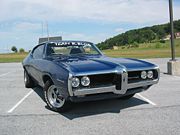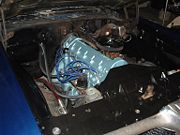
Pontiac Custom S
Encyclopedia


Pontiac
Pontiac was an automobile brand that was established in 1926 as a companion make for General Motors' Oakland. Quickly overtaking its parent in popularity, it supplanted the Oakland brand entirely by 1933 and, for most of its life, became a companion make for Chevrolet. Pontiac was sold in the...
Custom S was a single model year car that was marketed between the Pontiac LeMans
Pontiac LeMans
The Pontiac LeMans was a model name applied to compact and intermediate-sized automobiles offered by the Pontiac division of General Motors from 1962 to 1981. The LeMans was replaced by the downsized Pontiac Bonneville for the 1982 model year...
and the Pontiac Tempest
Pontiac Tempest
The Pontiac Tempest was an entry-level compact produced by the Pontiac Motor Division of General Motors, introduced in September 1960 for the 1961 model year....
. For reasons unknown, this one-year only nameplate replaced the previous model years Tempest Custom name in the Pontiac line-up.
The Custom S was only available for the 1969 model year. The car was originally to be called the "Pontiac TC".
It was available in six different body designs: two-door convertible
Convertible
A convertible is a type of automobile in which the roof can retract and fold away having windows which wind-down inside the doors, converting it from an enclosed to an open-air vehicle...
(VIN #'s starting with 23567xxxxx), hardtop
Hardtop
A hardtop is a term for a rigid, rather than canvas, automobile roof. It has been used in several contexts: detachable hardtops, retractable hardtop roofs, and the so-called pillarless hardtop body style....
coupe (VIN 23537xxxxx), sports coupe (VIN 23527xxxxx), a 4-door sedan (VIN 23569xxxxx), a 4-door hardtop (VIN 23539xxxxx), and a station wagon (VIN #'s 23535 and 23536 that depended on how the tailgate was hinged). The sports coupe can be differentiated from the hardtop by the presence of a vent window
Quarter glass
Quarter glass on automobiles and closed carriages may be a side window in the front door or located on each side of the car just forward of the rear window of the vehicle. Only some cars have them. In some cases the fixed quarter glass may set in the corner or "C-pillar" of the vehicle...
in the front door. Interior and exterior appointments were more lavish than the base Tempest but not quite as luxurious as the LeMans and GTO.
The Custom S came standard with Pontiac's unique overhead camshaft
Overhead camshaft
Overhead cam valvetrain configurations place the engine camshaft within the cylinder heads, above the combustion chambers, and drive the valves or lifters in a more direct manner compared to overhead valves and pushrods...
OHC-6 175 hp 250 in³ engine. Also available was a 230 hp 265 ft·lbf (359.3 N·m) TQ OHC inline 6-cylinder with the "Sprint" package, a 265 hp overhead valve pushrod V8 350 in³, and a 330 hp version of the same engine with higher compression and a 4-barrel carburetor
Carburetor
A carburetor , carburettor, or carburetter is a device that blends air and fuel for an internal combustion engine. It is sometimes shortened to carb in North America and the United Kingdom....
.
Originally planned for 1969 was a lower-priced junior musclecar to be based on the Custom S series, and a competitor to the inexpensive and fast-selling Plymouth Road Runner
Plymouth Road Runner
The Plymouth Road Runner was a muscle car built by the Plymouth division of the Chrysler Corporation in the United States between 1968 and 1980. In 1968, the first muscle cars were, in the opinion of many, moving away from their roots as relatively cheap, fast cars as they gained options...
, which started the econo-musclecar trend in 1968 due to a starting price of under $3,000 (by this time the GTO
Pontiac GTO
The Pontiac GTO is an automobile built by Pontiac Division of General Motors in the United States from 1964 to 1974, and by GM subsidiary Holden in Australia from 2004 to 2006. It is considered an innovative, and now classic muscle car of the 1960s and 1970s...
and similar upscale musclecars had starting prices closer to $3,500 and optioned-out cars often sold in the $4,500-$5,000 range - too expensive for younger buyers for which marketing of musclecars was aimed at). This car was to be built on the two-door pillared coupe bodystyle and be powered by the 330-horsepower 350 HO V8 with other equipment including the Custom S's bench-seat interior and exterior with Carousel Red paint, Rally II wheels sans trim rings and sporty striping. This car, which was said to have been named the "Pontiac ET" (for elapsed time), was presented to division officials but rejected as presented. Instead of the lower-priced musclecar concept, Pontiac decided to retain the flamboyant paint job and striping ... and offer it as "The Judge" option on the GTO, which further jacked up the GTO's price.
The Custom S nameplate was dropped after the 1969 model year. For 1970, that series was replaced by a new base LeMans line with the same bodystyles, while the previous up-level LeMans became the LeMans Sport. The entry level Tempest continued for one more year with a new T-37 hardtop coupe added at mid-year, that included a GT-37 option package as lower-priced junior musclecar available with 350 and 400 V8s somewhat similar to the abortive '69 ET series. The T-37 nameplate replaced Tempest entirely for the entry-level Pontiac intermediate series in 1971.

